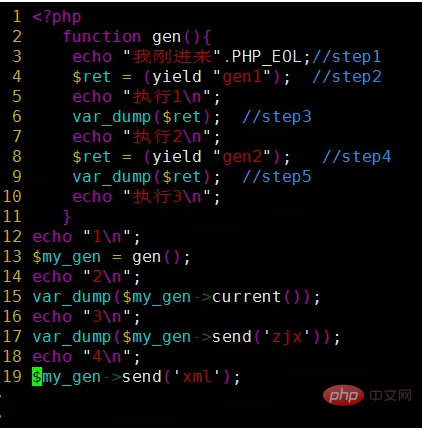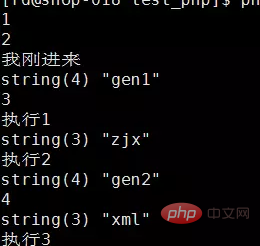How to understand php thread coroutine

Understanding of threads and coroutines in php
1. Threads
Threads are also called lightweight Process, which is a basic CPU execution unit and the smallest unit in the program execution process, is composed of thread ID, program counter, register set and stack. The introduction of threads reduces the overhead of concurrent execution of programs and improves the concurrency performance of the operating system. Threads do not have their own system resources.
The advantage of threads over processes is that they are faster. Whether it is creating a new thread or terminating a thread; whether it is switching between threads or sharing data or communication between threads, its speed is faster than that of a process. Big advantage.
The emergence of threads is to reduce the consumption of context switching, improve the concurrency of the system, and break through the defect that one process can only do one thing, making intra-process concurrency possible.
2. Coroutine
Coroutine is a user-mode thread. To understand what a "user-mode thread" is, you must first understand What is "kernel state thread". Kernel state threads are scheduled by the operating system. When switching thread contexts, you must first save the context of the previous thread, and then execute the next thread. When the conditions are met, switch back to the previous thread and restore the context. The same is true for coroutines, except that user-mode threads are not scheduled by the operating system, but by programmers, in user-mode.
yieldThis keyword is used to generate an interrupt and save the current context. For example, if a piece of code in the program accesses a remote server, then the CPU is idle at this time, so use Yield gives up the CPU, and then executes the next piece of code. If the next piece of code still accesses other resources besides the CPU, you can also call yield to give up the CPU. Continue execution, so that you can write asynchronous code in a synchronous way. .
①The emergence of coroutines
Before the emergence of coroutines, multi-tasking concurrency must be achieved. In the era of no OS (operating system), the idea of state machines can be used to implement multi-tasking. Disassemble and run multiple tasks in a single-process environment, but this mode requires developers to have a clear understanding of each task, and developers also need to develop task-related functions (such as communication between tasks) by themselves.
Later, OS (operating system) appeared, and we began to use the process and thread functions provided by OS to easily achieve multitasking. In the OS, process context switching is controlled by the OS kernel. But then a problem arose. Frequent process context switching led to a decrease in OS performance (mainly short-term execution of low-consuming task processes).
In order to solve this problem, a new concept began to be proposed, which is to run multiple tasks in the same process or thread. This problem is equivalent to returning to the early multi-tasking implementation in the OS-free era. And now the solution is called coroutines. Its essence is to transfer part of the task switching from the kernel to the application layer.
②Basic tools and basic uses of coroutines in PHP
To implement coroutines, PHP provides two new things: generator and yield keyword.
(1)What is a generator?
The generator inherits and implements the iterator, which is similar to the function definition in the PHP code, but uses the yield keyword internally, such as:

When used, it looks like this:

Okay, what does it mean to use it like this?
(1) First, $my_gen = gen(); this code just instantiates a new generator, the code inside is not executed;
(2) $my_gen->current(); The code executes yield "gen1" in step 2 in the generator. At this time, the code is interrupted, and the string "gen1" is passed into the generator $my_gen, and is used as the return value of the current() function;
If you continue to use the current() method to call here, the result will not change. The return value of $my_gen is still gen1
(3) After send("main send") is executed, the string "main send" is The generator $my_gen is passed in, and the generator is passed to ret as the return value of yield in step 2; through the send() method, the previous context will be found and continues downward.
(4) After the generator step3 is executed, when step4 is encountered, it will interrupt again when it encounters yield.
The above content is for reference only!
Recommended tutorial: PHP video tutorial
The above is the detailed content of How to understand php thread coroutine. For more information, please follow other related articles on the PHP Chinese website!

Hot AI Tools

Undresser.AI Undress
AI-powered app for creating realistic nude photos

AI Clothes Remover
Online AI tool for removing clothes from photos.

Undress AI Tool
Undress images for free

Clothoff.io
AI clothes remover

Video Face Swap
Swap faces in any video effortlessly with our completely free AI face swap tool!

Hot Article

Hot Tools

Notepad++7.3.1
Easy-to-use and free code editor

SublimeText3 Chinese version
Chinese version, very easy to use

Zend Studio 13.0.1
Powerful PHP integrated development environment

Dreamweaver CS6
Visual web development tools

SublimeText3 Mac version
God-level code editing software (SublimeText3)

Hot Topics
 1662
1662
 14
14
 1419
1419
 52
52
 1312
1312
 25
25
 1262
1262
 29
29
 1235
1235
 24
24
 How do you parse and process HTML/XML in PHP?
Feb 07, 2025 am 11:57 AM
How do you parse and process HTML/XML in PHP?
Feb 07, 2025 am 11:57 AM
This tutorial demonstrates how to efficiently process XML documents using PHP. XML (eXtensible Markup Language) is a versatile text-based markup language designed for both human readability and machine parsing. It's commonly used for data storage an
 Explain JSON Web Tokens (JWT) and their use case in PHP APIs.
Apr 05, 2025 am 12:04 AM
Explain JSON Web Tokens (JWT) and their use case in PHP APIs.
Apr 05, 2025 am 12:04 AM
JWT is an open standard based on JSON, used to securely transmit information between parties, mainly for identity authentication and information exchange. 1. JWT consists of three parts: Header, Payload and Signature. 2. The working principle of JWT includes three steps: generating JWT, verifying JWT and parsing Payload. 3. When using JWT for authentication in PHP, JWT can be generated and verified, and user role and permission information can be included in advanced usage. 4. Common errors include signature verification failure, token expiration, and payload oversized. Debugging skills include using debugging tools and logging. 5. Performance optimization and best practices include using appropriate signature algorithms, setting validity periods reasonably,
 Explain late static binding in PHP (static::).
Apr 03, 2025 am 12:04 AM
Explain late static binding in PHP (static::).
Apr 03, 2025 am 12:04 AM
Static binding (static::) implements late static binding (LSB) in PHP, allowing calling classes to be referenced in static contexts rather than defining classes. 1) The parsing process is performed at runtime, 2) Look up the call class in the inheritance relationship, 3) It may bring performance overhead.
 PHP Program to Count Vowels in a String
Feb 07, 2025 pm 12:12 PM
PHP Program to Count Vowels in a String
Feb 07, 2025 pm 12:12 PM
A string is a sequence of characters, including letters, numbers, and symbols. This tutorial will learn how to calculate the number of vowels in a given string in PHP using different methods. The vowels in English are a, e, i, o, u, and they can be uppercase or lowercase. What is a vowel? Vowels are alphabetic characters that represent a specific pronunciation. There are five vowels in English, including uppercase and lowercase: a, e, i, o, u Example 1 Input: String = "Tutorialspoint" Output: 6 explain The vowels in the string "Tutorialspoint" are u, o, i, a, o, i. There are 6 yuan in total
 What are PHP magic methods (__construct, __destruct, __call, __get, __set, etc.) and provide use cases?
Apr 03, 2025 am 12:03 AM
What are PHP magic methods (__construct, __destruct, __call, __get, __set, etc.) and provide use cases?
Apr 03, 2025 am 12:03 AM
What are the magic methods of PHP? PHP's magic methods include: 1.\_\_construct, used to initialize objects; 2.\_\_destruct, used to clean up resources; 3.\_\_call, handle non-existent method calls; 4.\_\_get, implement dynamic attribute access; 5.\_\_set, implement dynamic attribute settings. These methods are automatically called in certain situations, improving code flexibility and efficiency.
 PHP and Python: Comparing Two Popular Programming Languages
Apr 14, 2025 am 12:13 AM
PHP and Python: Comparing Two Popular Programming Languages
Apr 14, 2025 am 12:13 AM
PHP and Python each have their own advantages, and choose according to project requirements. 1.PHP is suitable for web development, especially for rapid development and maintenance of websites. 2. Python is suitable for data science, machine learning and artificial intelligence, with concise syntax and suitable for beginners.
 PHP in Action: Real-World Examples and Applications
Apr 14, 2025 am 12:19 AM
PHP in Action: Real-World Examples and Applications
Apr 14, 2025 am 12:19 AM
PHP is widely used in e-commerce, content management systems and API development. 1) E-commerce: used for shopping cart function and payment processing. 2) Content management system: used for dynamic content generation and user management. 3) API development: used for RESTful API development and API security. Through performance optimization and best practices, the efficiency and maintainability of PHP applications are improved.
 PHP: A Key Language for Web Development
Apr 13, 2025 am 12:08 AM
PHP: A Key Language for Web Development
Apr 13, 2025 am 12:08 AM
PHP is a scripting language widely used on the server side, especially suitable for web development. 1.PHP can embed HTML, process HTTP requests and responses, and supports a variety of databases. 2.PHP is used to generate dynamic web content, process form data, access databases, etc., with strong community support and open source resources. 3. PHP is an interpreted language, and the execution process includes lexical analysis, grammatical analysis, compilation and execution. 4.PHP can be combined with MySQL for advanced applications such as user registration systems. 5. When debugging PHP, you can use functions such as error_reporting() and var_dump(). 6. Optimize PHP code to use caching mechanisms, optimize database queries and use built-in functions. 7




